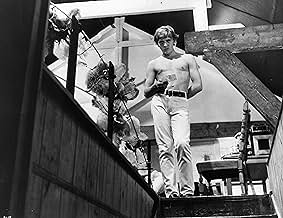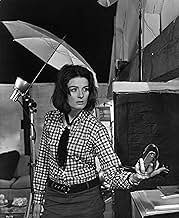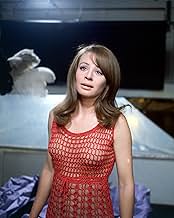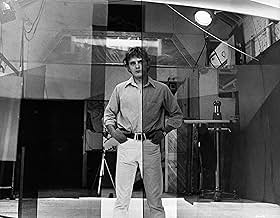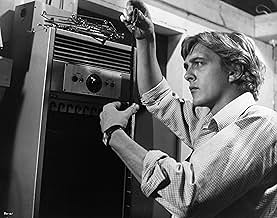Blow-Up
- 1966
- Tous publics
- 1h 51m
A fashion photographer unknowingly captures a death on film after following two lovers in a park.A fashion photographer unknowingly captures a death on film after following two lovers in a park.A fashion photographer unknowingly captures a death on film after following two lovers in a park.
- Nominated for 2 Oscars
- 8 wins & 9 nominations total
Veruschka von Lehndorff
- Verushka
- (as Verushka)
Jeff Beck
- Self - The Yardbirds
- (uncredited)
Roy Beck
- Boy dancing In Ricki Tick Club
- (uncredited)
Charlie Bird
- Homeless Man
- (uncredited)
Susan Brodrick
- Antique shop owner
- (uncredited)
Robin Burns
- Homeless Man
- (uncredited)
Tsai Chin
- Thomas's receptionist
- (uncredited)
Julio Cortázar
- Homeless Man
- (uncredited)
Chris Dreja
- Self - The Yardbirds
- (uncredited)
Featured reviews
I would recommend that people who are considering watching this film for the first time not read the following. I don't mention the film's ending, I just believe its far more satisfying to let the films potent details nervously sink into place on their own.
It is not about cameras. It is not about seeing. It is about our perception of our individual world. It throws shadows on the very judgments we build our lives upon. Without mentioning the obvious references to illusion (the mimes, the abstract picture of the corpse, etc.), I offer the following expert signposts Antonioni leaves for us to find.
1) The guitar neck David snatches at the rave-up has value only until he is not being chased for it, whereupon he discards it in the street. The pedestrian who then picks it up sees it only as junk.
2) Dialogue with his model friend at the pot party: DAVID - ` I thought you were in Paris.' THE GIRL - `I am'.
3) Appearances and Disappearance (2 of the many). The Lynn Redgrave character pops up as he arrives at his apartment. His question `How did you find me' is not explained. Later in the story, it is notably odd when David wakes up the following morning after the pot party that there is no one to be seen in the party house. Even the decorations like the clothes hung on the statue the night before have vanished.
4) David teaches the affectations of smoking to the woman. She must create an impression.
5) His painter friend describes his painting. `They don't mean anything to me while I work on them. Its only later that I ascribed something to them. Like this leg.' Whereupon he points out a place in a painting that might be a human leg. When he paints, he is tapping subconscious language, something apart from subjective and objective reality. Its as if Antonioni is offering us an even further vantage point to the events to come, dream reality.
6) The rambling diversion of events shows David's inability to `focus' on working through his mystery.
7) So much is hidden from the viewer. Its almost suggested that the real end to the narrative takes place someplace after the movie has already finished, jarring our sense of story, insinuating an ending we never get to `see'.
8) David announces at one point to his friend, `If only I had more money I'd be all right.'. Meanwhile he drives through the whole movie in his Rolls Royce.
This is a very remarkable film. I was irked by the pacing and the diversions as I watched it, but that was exactly why it all kept coming and coming at me for hours after until finally in bed it all rushed through me like a gorgeous musical event. I know for certain there are many more hidden corners to it, but this is what I got in my first viewing. Just that gut feeling that I missed something, I believe, is exactly where Antonioni was going. You always miss something.
It is not about cameras. It is not about seeing. It is about our perception of our individual world. It throws shadows on the very judgments we build our lives upon. Without mentioning the obvious references to illusion (the mimes, the abstract picture of the corpse, etc.), I offer the following expert signposts Antonioni leaves for us to find.
1) The guitar neck David snatches at the rave-up has value only until he is not being chased for it, whereupon he discards it in the street. The pedestrian who then picks it up sees it only as junk.
2) Dialogue with his model friend at the pot party: DAVID - ` I thought you were in Paris.' THE GIRL - `I am'.
3) Appearances and Disappearance (2 of the many). The Lynn Redgrave character pops up as he arrives at his apartment. His question `How did you find me' is not explained. Later in the story, it is notably odd when David wakes up the following morning after the pot party that there is no one to be seen in the party house. Even the decorations like the clothes hung on the statue the night before have vanished.
4) David teaches the affectations of smoking to the woman. She must create an impression.
5) His painter friend describes his painting. `They don't mean anything to me while I work on them. Its only later that I ascribed something to them. Like this leg.' Whereupon he points out a place in a painting that might be a human leg. When he paints, he is tapping subconscious language, something apart from subjective and objective reality. Its as if Antonioni is offering us an even further vantage point to the events to come, dream reality.
6) The rambling diversion of events shows David's inability to `focus' on working through his mystery.
7) So much is hidden from the viewer. Its almost suggested that the real end to the narrative takes place someplace after the movie has already finished, jarring our sense of story, insinuating an ending we never get to `see'.
8) David announces at one point to his friend, `If only I had more money I'd be all right.'. Meanwhile he drives through the whole movie in his Rolls Royce.
This is a very remarkable film. I was irked by the pacing and the diversions as I watched it, but that was exactly why it all kept coming and coming at me for hours after until finally in bed it all rushed through me like a gorgeous musical event. I know for certain there are many more hidden corners to it, but this is what I got in my first viewing. Just that gut feeling that I missed something, I believe, is exactly where Antonioni was going. You always miss something.
Blow Up is the quintessential 60' s movie with a roster of talented British actors, colourful mod fashions (now back in vogue), dreary post-war London locations and empty streets, groovy music by American composer extraordinaire Herbie Hancock and an Italian director and writer in love with the whole scene. Blow Up is the cinematic equivalent of the TR4 cabriolet, designed by Michelotti and manufactured by Triumph during the same period, and mixes the best of two rather different cultures. The movie offers the right amount of nudity, sensuality and perversion without offending the prude status quo of swinging Olde England. David Hemmings plays a character who is by all accounts snobbish, homophobic, prejudiced, rude and macho. This pseudo thriller/whodunit unwinds rather slowly and with little dialogue and, I think, is just an excuse for Antonioni to show how weird the English were. A must see flick for the ones nostalgic or who missed the 60' s completely.
Antonioni was not a director that worried too much about people completely understanding his films. In fact I'd bet that he actually hoped they didn't understand everything. So I did not find it strange or surprising when after finishing the movie I felt quite confused. But the movie made me think for a very long time, which in my opinion is what a good film should do. There are so many aspects to this film that if you give them a chance and think about them, they will keep you reeling for hours on possible interpretations. The first and probably most important aspect of this film dealt with love. From what I have seen of his films, love is Antonioni's favorite subject. But this love was different than that of past films; it is much more shallow and un-centered. Thomas, the photographer, is surrounded by women, he goes from one to the next without thinking twice, treating them like dogs the entire time. But he can do this and get away with it because he is a famous photographer and can make the women what they all desperately want to be, Beautiful. For The first half of the movie I honestly did not like his character whatsoever. Whereas in the past the director has chosen mainly to explore the ups and downs of married life, or the problems of being hopelessly devoted to one person, he now points the camera at the single, care free, over sexed, youth of the sixties. Half an hour into the movie I found myself wondering what the heart of the film was going to be. We were introduced to Thomas and his world, but there seemed to be no conflict driving the story forward. Then came the quasi-murder mystery. This is what is really interesting and unique about this film in my opinion. Antonioni for a while leads us to believe that the movie is going to turn into some suspense thriller, or murder mystery, but never seems to quite get there. He has all the elements ready to go, but never follows through with them. He introduces this alluring and mysterious woman who is in on the murder and then never brings her back. The murder victim is discovered, but his identity is never revealed, nor a motive given for his murder. Thomas, after a very energetic and exciting photo investigation seems to not really care too much as to what happens with the investigations results, only telling a couple of his friends who couldn't care less. Antonioni seems to have used this whole murder mystery convention as some sort of glue to hold the rest of the real story together. The story of a mindless, beauty obsessed, celebrity idolizing, drug addicted, and violence obsessed culture. Probably my favorite scene in the film is after fighting over the piece of broken guitar with the other fans; Thomas just discards his prize as garbage. Something that kept bugging me was the antique shop. I kept wondering what in the world it had to do with anything in the movie; it stuck out like a sore thumb. But I knew it that there was some major purpose or explanation for its existence in the film, and then it just kind of clicked. Upon his first entry into the Antique store Thomas encounters an angry old man who we eventually find out is not the stores real owner, the true owner is a beautiful young woman who is planning to sell the old place and travel the world in search of something new. All this stuff she owns, the gold of past cultures, is old and useless now. She has a hard time making a living because nobody wants the stuff any longer. Here is where I think Antonioni's major message is hidden: That is the way life is, it moves on constantly, things change, people die, cultures evolve and the only thing that remains in the end is nature itself. Antonioni finishes the film beautifully, Thomas stands alone in a large field of grass, the only thing heard is the wind and the trees, as the camera backs away slowly, he disappears leaving nothing but the grass blowing in the wind, for like all the antiques and all the people that created them in the past, eventually Thomas's life will end and so will the current popular culture in which he takes part. Change is life's only constant.
Antonioni's Blow-Up was the biggest hit of the Italian director's career, the superficial elements of the fashion world, Swinging London and orgies on purple paper ensuring its commercial success.
Models such as Veruschka (who appears in the film), Twiggy and fashion photographers at the time have complained about its unrealistic depiction of the industry and claimed that its central character, Thomas (played by the late David Hemmings) was clearly based on David Bailey.
To look at Blow-Up as an analysis of the fashion business in the Sixties is to misunderstand the film's intentions. In any case, when watching this film it may be difficult to tell what its all about if you're unfamiliar with Antonioni's films but it obviously has little to do with the fashion world which is merely the setting for the story and nothing more.
Antonioni made the clearest statement of his motivation as a filmmaker at the end of Beyond the Clouds when he talked about his belief that reality is unattainable as it is submerged by layers of images which are only versions of reality.
This is a rather pretentious way of saying that everyone perceives reality in their own way and ultimately see only what they want to see.
With this philosophy in mind, Blow-Up is probably Antonioni's most personal film.
Thomas' hollow, self-obsessed world is shattered when he discovers that he may have photographed a murder when casually taking pictures in a park. He encounters a mysterious woman, Jane (Vanessa Redgrave) who demands he hand over the film and when he refuses she appears at his studio, although Thomas never told her his address.
When the evidence disappears shortly afterwards, Blow-Up seems to deal in riddles that have no solution. Redgrave re-appears and then vanishes before the photographer's eyes, Thomas returns to the park without his camera and sees the body. The film concludes with Thomas, having discovered the body has disappeared, watching a group of mimes playing tennis without a ball or rackets in the park where the murder may have taken place.
It is only in the final scene of the film where the riddle is solved. Thomas throws the imaginary ball back into the court and watches the game resume. The look of realisation on his face is all too apparent as the game CAN BE HEARD taking place out of shot.
There is a ball, there are rackets and this is a real game of tennis. What we have seen up until this point is the photographer's perception of reality: the murder, the mysterious woman in the park, the photographic evidence and the body.
The following exchange between Hemmings and Redgrave is the key to the film:
Thomas: Don't let's spoil everything, we've only just met.
Jane: No, we haven't met. You've never seen me.
Models such as Veruschka (who appears in the film), Twiggy and fashion photographers at the time have complained about its unrealistic depiction of the industry and claimed that its central character, Thomas (played by the late David Hemmings) was clearly based on David Bailey.
To look at Blow-Up as an analysis of the fashion business in the Sixties is to misunderstand the film's intentions. In any case, when watching this film it may be difficult to tell what its all about if you're unfamiliar with Antonioni's films but it obviously has little to do with the fashion world which is merely the setting for the story and nothing more.
Antonioni made the clearest statement of his motivation as a filmmaker at the end of Beyond the Clouds when he talked about his belief that reality is unattainable as it is submerged by layers of images which are only versions of reality.
This is a rather pretentious way of saying that everyone perceives reality in their own way and ultimately see only what they want to see.
With this philosophy in mind, Blow-Up is probably Antonioni's most personal film.
Thomas' hollow, self-obsessed world is shattered when he discovers that he may have photographed a murder when casually taking pictures in a park. He encounters a mysterious woman, Jane (Vanessa Redgrave) who demands he hand over the film and when he refuses she appears at his studio, although Thomas never told her his address.
When the evidence disappears shortly afterwards, Blow-Up seems to deal in riddles that have no solution. Redgrave re-appears and then vanishes before the photographer's eyes, Thomas returns to the park without his camera and sees the body. The film concludes with Thomas, having discovered the body has disappeared, watching a group of mimes playing tennis without a ball or rackets in the park where the murder may have taken place.
It is only in the final scene of the film where the riddle is solved. Thomas throws the imaginary ball back into the court and watches the game resume. The look of realisation on his face is all too apparent as the game CAN BE HEARD taking place out of shot.
There is a ball, there are rackets and this is a real game of tennis. What we have seen up until this point is the photographer's perception of reality: the murder, the mysterious woman in the park, the photographic evidence and the body.
The following exchange between Hemmings and Redgrave is the key to the film:
Thomas: Don't let's spoil everything, we've only just met.
Jane: No, we haven't met. You've never seen me.
I realize that this is a cinema classic, taught in cinema courses everywhere. And I recognize that there is some pretty remarkable stuff here. But some of it I found very off-putting.
First, to the good: the cinematography is almost constantly remarkable. The way scenes are framed, the constant variation of camera angles, the switches between close and far, etc. I almost would have preferred this without sound. There was so much of interest to watch.
There was little of interest to hear, however. The dialogue is inane. And the protagonist is an egotistical, selfish, thoroughly repugnant excuse for a man. Maybe he's alienated from his world. Why would I care? He does everything to demonstrate that he cares about nothing and no one but himself.
Just past the midpoint of this movie, it starts to become interesting when the photographer detects something in the background of one of his photos. When it turns out a man was murdered, he wants to know more. But why? He's never shown any interest in anything other than himself up until then?
And, finally, he seems to forget about it all.
Watch this once for the amazing camerawork. But as for the plot, the characters, and the rest, don't expect to be engaged. I certainly wasn't.
First, to the good: the cinematography is almost constantly remarkable. The way scenes are framed, the constant variation of camera angles, the switches between close and far, etc. I almost would have preferred this without sound. There was so much of interest to watch.
There was little of interest to hear, however. The dialogue is inane. And the protagonist is an egotistical, selfish, thoroughly repugnant excuse for a man. Maybe he's alienated from his world. Why would I care? He does everything to demonstrate that he cares about nothing and no one but himself.
Just past the midpoint of this movie, it starts to become interesting when the photographer detects something in the background of one of his photos. When it turns out a man was murdered, he wants to know more. But why? He's never shown any interest in anything other than himself up until then?
And, finally, he seems to forget about it all.
Watch this once for the amazing camerawork. But as for the plot, the characters, and the rest, don't expect to be engaged. I certainly wasn't.
Did you know
- TriviaThe film contains a rare performance of The Yardbirds during the period when Jimmy Page and Jeff Beck were both in the band. Jeff Beck would leave a few months later.
- GoofsWhen Thomas is frolicking with the two girls on the purple paper backdrop in the studio, two crew members, including a camera operator, can be seen just sitting there in the top right side of the frame.
- Alternate versionsSome of the music was rescored for the Warner DVD release, namely the latter part of the opening title music. The VHS releases' music remain intact.
- ConnectionsFeatured in Film Review: How I Learned to Live with Being a Star (1967)
- SoundtracksMain Title (Blow-Up)
Written and Performed by Herbie Hancock
- How long is Blow-Up?Powered by Alexa
Details
- Release date
- Countries of origin
- Official site
- Language
- Also known as
- Deseo de una mañana de verano
- Filming locations
- Maryon Park, Woolwich Road, Charlton, London, England, UK(scenes where Thomas first photographs Jane and where mime artists play tennis at the end)
- Production companies
- See more company credits at IMDbPro
Box office
- Budget
- $1,800,000 (estimated)
- Gross worldwide
- $38,575
- Runtime
- 1h 51m(111 min)
- Sound mix
- Aspect ratio
- 1.85 : 1
Contribute to this page
Suggest an edit or add missing content



